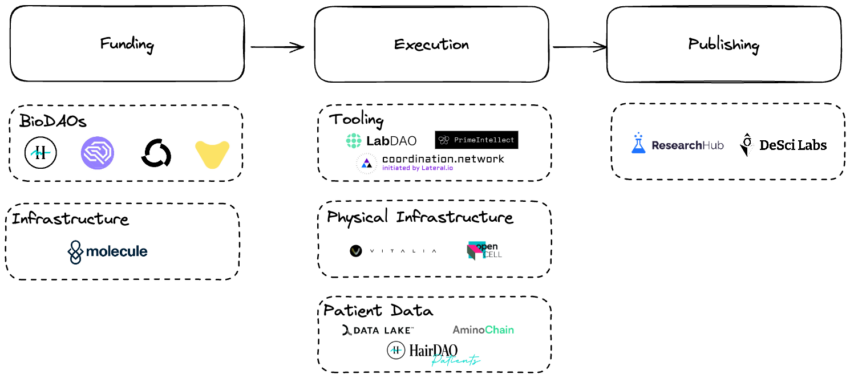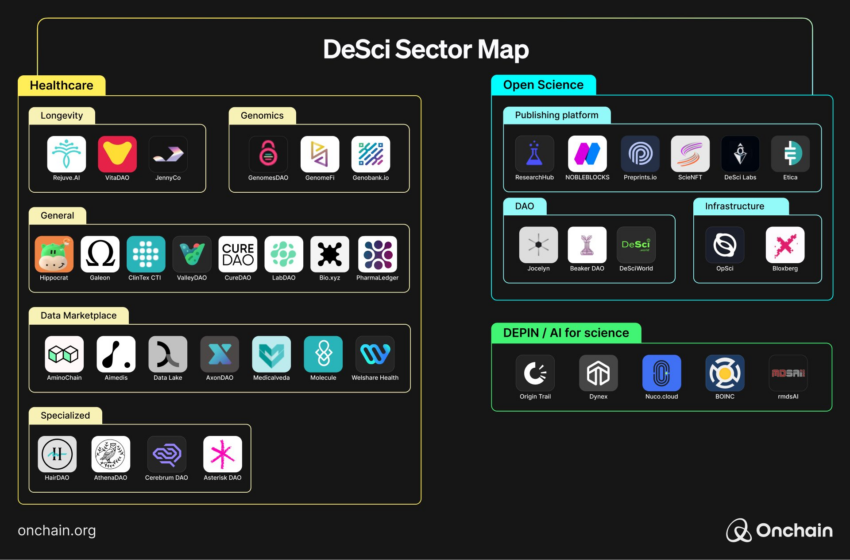The Future of Research: VitaDAO Executive Sheds Light on DeSci and Blockchain’s Role
Decentralized science (DeSci) has been making strides in the crypto community this year, creating expectations on how the use of blockchain technology and tokenized funding novels can produce research beyond traditional systems.
BeInCrypto spoke with VitaDAO’s Maria Marinova to understand DeSci’s funding model, its use of decentralized autonomous organizations (DAOs) for transparency and governance, and the movement’s future prospects.
Decentralized Science uses blockchain technology to enhance scientific research and collaboration. By employing tokens, NFTs, and DAOs, DeSci promotes openness, incentivizes contributions, and enables community-driven decision-making. Blockchain ensures secure data storage, while DAOs facilitate the framework and transparent governance.
DeSci provides financial incentives through token rewards and reputation systems. Smart contracts can automate immutable and verifiable peer review, encouraging researchers to produce reliable scientific work.
 The DeSci Value Chain (2024). Source: Patrick Mayr
The DeSci Value Chain (2024). Source: Patrick Mayr
Unlike traditional science, DeSci enables crowdfunding and facilitates transparent intellectual property (IP) rights. Blockchain technology provides a secure record of IP ownership and transactions. This is especially valuable in collaborative research settings, where multiple parties contribute simultaneously.
DeSci also gives scientists a higher degree of freedom to pursue experimental projects, adds Maria Marinova.
“Traditional funding models often reward safe, incremental projects while sidelining high-risk, high-reward research that could drive transformative breakthroughs. This conservatism stems from a system that prioritizes predictable outcomes and aligns with established paradigms, creating a bottleneck for disruptive innovation. DeSci fundamentally reimagines these mechanisms by promoting transparency, democratizing funding decisions, and incentivizing bold research,” Marinova told BeInCrypto.
Among other noteworthy features, DeSci removes paywalls for crucial research, making it more accessible. It also applies community-driven funding models through cryptocurrencies or DAOs to allocate research funds.
Projects and Use CasesA prominent project that had success in the DeSci sector this year was Pump.Science, a platform that leverages gamification to explore potential longevity-enhancing treatments. It employs a tiered testing system, beginning with simple organisms and progressing to more complex models.
 DeSci Sector Map. Source: Onchain Foundation
DeSci Sector Map. Source: Onchain Foundation
Pump.science operates a tokenized prediction market. Users can purchase tokens tied to specific longevity treatments, indicating their belief in the treatment’s potential.
As treatments advance through testing stages, live-streamed data is made available, allowing users to make predictions based on ongoing results. Token sales at predefined milestones fund further experimentation.
“Prediction markets are a promising tool for prioritizing research and fostering collaboration. They can harness collective intelligence to evaluate hypotheses, direct funding, or predict the likelihood of success for projects. They could also help prioritize research, test hypotheses, and even predict the success of projects. But they need to be designed carefully to avoid ethical pitfalls,” Marinova told BeInCrypto.
VitaDAO is another platform that focuses on leveraging blockchain technology to democratize longevity research. It has pioneered the use of IP-NFTs and IPTs, turning research ownership into tradeable assets. Community members utilize the VITA governance token to fund projects and share in their success.
“Through DAOs like VitaDAO, funding becomes community-driven, leveraging mechanisms like quadratic funding to align incentives with public interest. This reduces biases, accelerates decision-making, and allows for broader participation,” Marinova added.
Beyond longevity research, other platforms take different approaches to decentralized scientific research. NobleBlocks, for example, is a blockchain-based scientific journal that aims to democratize access to research and publishing.
By using blockchain technology, NobleBlocks ensures the immutability and chronological order of research data, providing a verifiable record of scientific discoveries.
To address the high costs associated with traditional scientific publishing, NobleBlocks eliminates steep article processing and subscription fees. Authors pay only for the peer review services they use, while editors and reviewers receive a nominal transaction fee in the form of tokens.
While DeSci has undeniably grown in the past year, it hasn’t yet secured its foothold in Web3. Before doing so, it needs to address certain challenges.
Many scientists, especially those not familiar with Web3, may find it difficult to understand and use blockchain technology. To make DeSci more widely adopted, it’s important to involve more researchers in its development and use.
For Marinova, mistrust and suspicion over DeSci are additional obstacles.
“Traditional academia often looks at DeSci with skepticism. To gain legitimacy, we need to prove we’re more than just hype and empty promises. That means showing real results—projects that make headlines for their impact, not just their novelty,” she told BeInCrypto.
Managing intellectual property rights in scientific research is one of the issues that DAOs currently face. Researchers often collaborate with institutions or companies, which can complicate ownership of research findings. To achieve its full potential, DeSci needs to develop legal frameworks that address potential conflicts between different actors.
“We also need to create clear standards for peer review, data sharing, and IP management so that everyone—from researchers to investors—can trust the system. It’s like building a bridge between two worlds: one rooted in centuries of tradition and the other racing towards the future,” Marinova added.
Tokenizing research using non-fungible tokens (NFTs) or similar methods also raises questions about how these digital assets will interact with existing patent and copyright laws.
Complying with aspects like financial regulations, data protection, and scientific research ethics can be similarly challenging in a decentralized environment.
Issues in Research QualityFrom another standpoint, DeSci projects must also find a way to ensure that only sound research is promoted. This problem proves difficult to solve, considering the open nature of blockchain technology.
While DeSci prioritizes accessibility, this could lead to situations where unqualified individuals may unintentionally support low-quality research because of a generalized lack of understanding, personal connections, or financial motivations.
This dynamic also raises questions about the nature of the scientific research that gets prioritized. Certain actors might prefer research that offers immediate commercial benefits, potentially neglecting fundamental research that may not have immediate financial returns.
In her interview, Marinova addresses how longevity research balances the need to meet market demand, while also creating a space where scientists can pursue more experimental initiatives.
“Longevity research is definitely having its moment, and why wouldn’t it? Everyone wants to live longer and healthier lives. But it’s not just market demand driving this focus—it’s also about showing what’s possible. Longevity is a bold, visionary field, and it fits perfectly with DeSci’s ethos of taking risks and breaking molds. The field resonates with crypto-native communities, who often embrace forward-thinking, transformative ideas. However, this focus does not signify a limitation in DeSci’s scope,” she told BeInCrypto.
DAOs can potentially bridge this gap by strategically allocating resources, like using profits from commercial projects, to fund more meaningful and long-term research. In turn, positive breakthroughs from fundamental research projects could then be used for commercial applications.
The Future of DeSciDespite challenges such as adoption barriers, unclear regulations, and intellectual property concerns, DeSci has the potential to reshape the way science approaches research.
By addressing these issues, it can effectively bridge the gap between traditional science and decentralization.
“The goal is to merge decentralized decision-making with peer-reviewed systems and transparent methodologies, creating a hybrid model that respects the rigor of traditional science while embracing the inclusivity of Web3”, Marinova explained.
There are also existing options that can attract researchers and investors alike, she added.
“To attract researchers, DeSci must offer unique advantages, such as faster funding cycles, equitable IP ownership, and the ability to pursue high-risk projects without jeopardizing careers. For investors, DeSci’s appeal lies in its transparency and impact-driven models. Platforms leveraging blockchain provide real-time tracking of funds, milestones, and results, ensuring accountability,” Marinova told BeInCrypto.
Since DeSci is still in its earlier stages of development, it has time to refine its approach to scientific research and polish areas that need to be revisited.
Its successes so far and its capacity to accelerate scientific discovery through collaboration and transparency remain promising to researchers looking to merge science with decentralization.
The post The Future of Research: VitaDAO Executive Sheds Light on DeSci and Blockchain’s Role appeared first on BeInCrypto.
